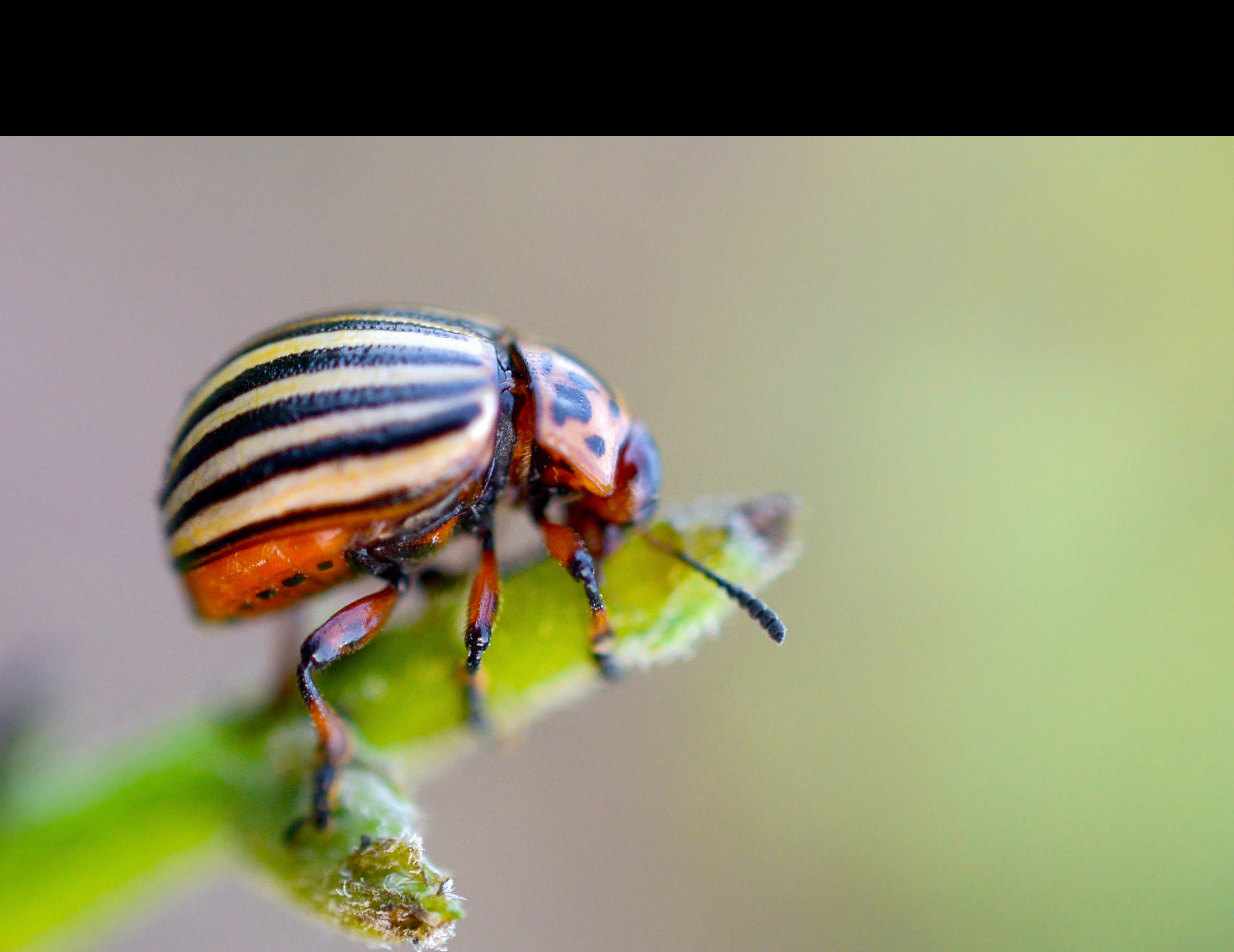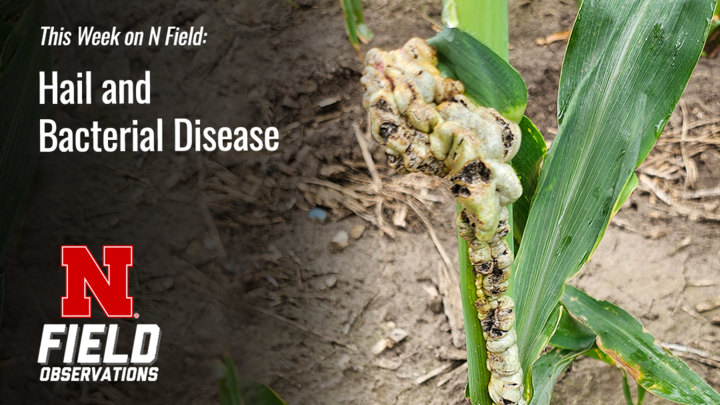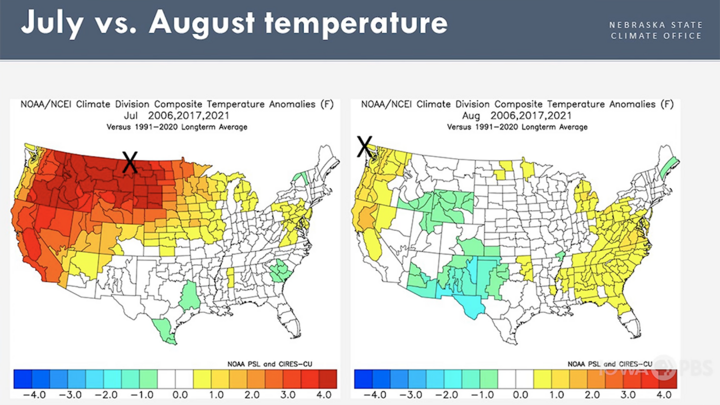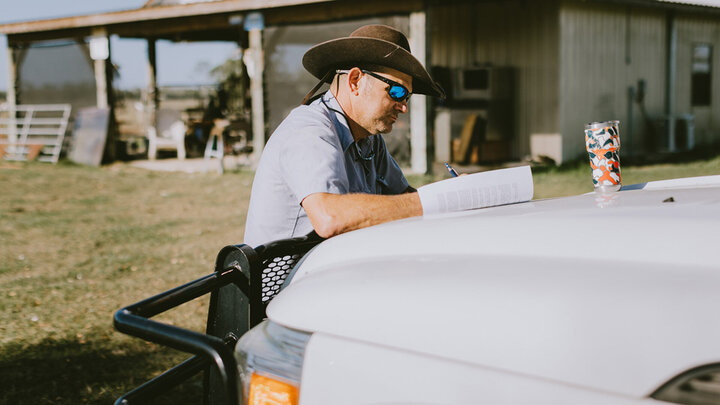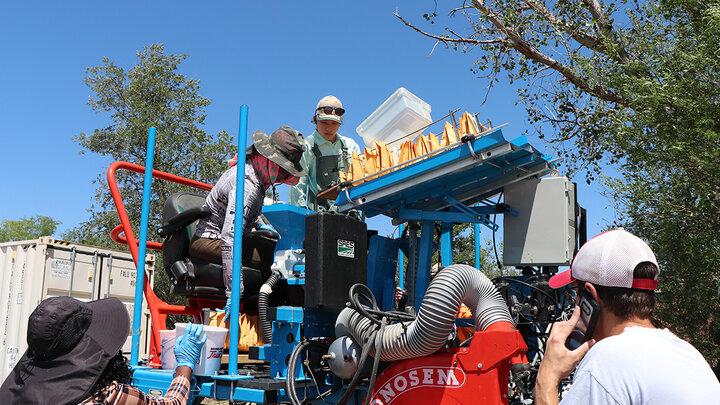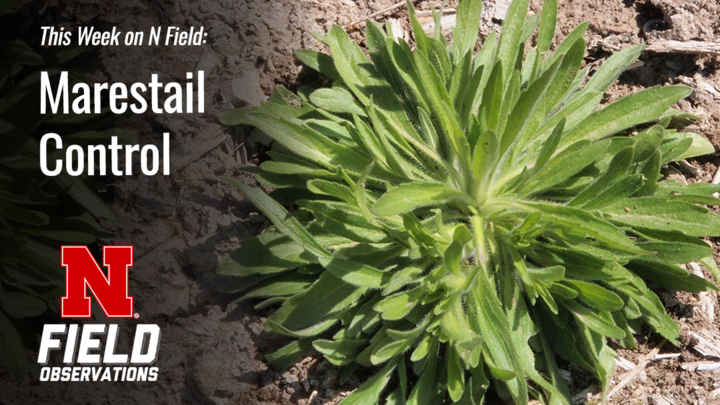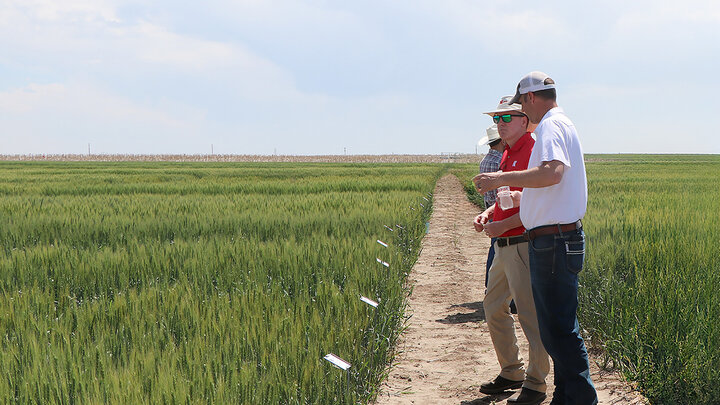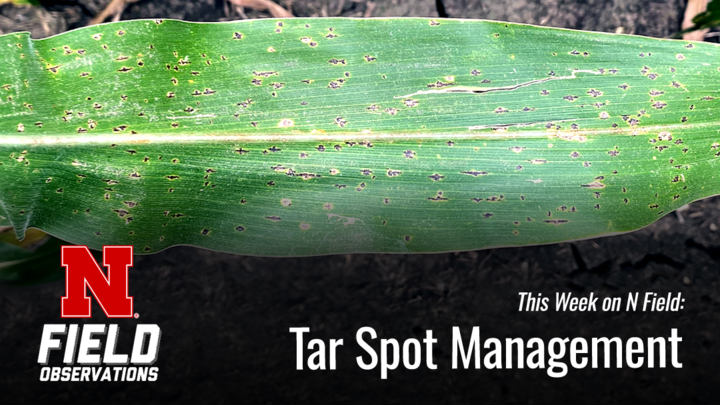Tuber Eating Insects
Wireworms
Click Beetle (adult) and Wireworm (larva)
Wireworms are the larvae of many species in several genera called click beetles. Wireworms cause the damage not the adult click beetles. Since every geographic location has its own set of species, to know which wireworms are causing damage to potato, it is necessary to trap them and identify those in the potato field. An infested field will remain infested for three to six years and planting there should be avoided.
Description
Adults are slender beetles whose appearance varies greatly since many genera and species comprise the group called click beetles which produce wireworms.
Larvae from click beetles are called wireworms and these are the damaging form of the insect. During the early stages lasting one to two years, wireworms are very small and white. Mature larvae lasting two to six years are hard-shelled with dark transverse bands along the length of their body. The body color is a shiny yellow to rust. There are six (three pairs) slender legs toward the head region. At the head, there is a pair of pincer-like protrusions. Wireworms are 1/2 to an inch long at maturity and easily visible in traps and occasionally may be found in or hanging from a potato tuber.
Eggs are laid and pupa are formed deep in the ground; eggs are laid in grassy areas.
Life Cycle
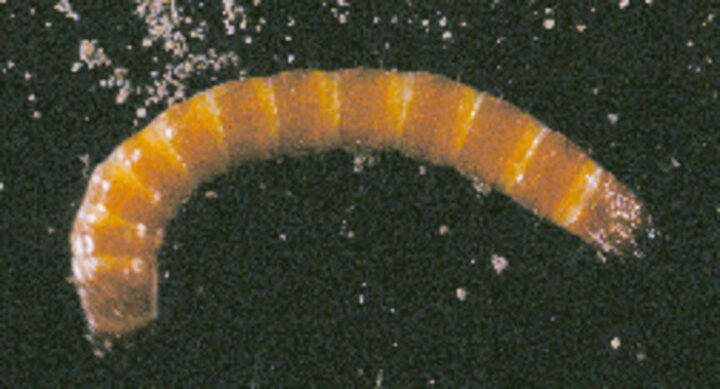
Adults (click beetles) are relatively common in the summer and are often attracted to lights at night. Their presence does not necessarily indicate future problems. They overwinter in survive in the soil for several months, overwintering, and emerge in the spring. Once mated, click beetles seek egg-laying sites in grassy areas which may be pastures or other sod areas. For this reason, wireworms, the larvae, are most likely to be a problem in fields that have recently been broken out of sod or grass crops. Click beetles also may seek to deposit eggs in areas of cultivated fields where grassy weeds are a problem or in cereal crops. Eggs hatch in a few days to weeks, and the larva or wireworm emerges.
Wireworms emerge in the soil and may survive for two to six years. In the winter, they survive about two feet deep and as the temperature worms move up through the ground to the top two to three inches of soil. Wireworms move up and down in the soil during the season depending on temperature. They prefer soil temperature to be 50 to 60oF. After wireworm achieve full maturity during the summer, they will pupate in the soil, and the pupae will transform into click beetles after a few days.
Damage
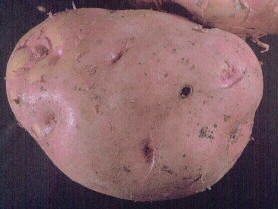
Wireworms, the larvae of click beetles, damage potato by feeding primarily on tubers. The damage appears as straight, round holes with smooth walls. It is not clear whether the wireworm feeding is due to a search for shelter or due to thirst and not actually eating. Early in the season around planting, wireworms may drill into seed tubers or seed-pieces thereby weakening them possibly resulting in secondary infection especially by soft rot, in reduced stands and in weakened young plants. Wireworms also can feed on young sprouts with the same results. During the season, although not common, wireworms could damage roots and underground stem. For potato, the major damage is later in the season when tubers are maturing after bulking. Late-season damage will result when larvae feed on tubers causing feeding scars or feeding tunnels. The result of this feeding is reduced quality of the harvested tubers. Wireworm damage is most likely the result of feeding by larvae that are 2 or more years old. In most situations larvae of several ages can be found in an infested field. This does not affect seed production as seed vigor is not affected but the damage causes culling for the fresh market. In processing, potato chips will show gaps along the margin where the hole was located and likewise french fries will show the gap at their ends.
Soil Sampling
Wireworms would likely cause significant problems only in a proportion of a field. Even in those fields where they are present, wireworm damage may be spotty. Soil sampling and baiting are somewhat effective at determining if wireworms are present in fields to be planted to potato. Wet wheat flour or germinating wheat, barley or oat seeds can be used to attract wireworm larvae into buried bait stations. These pests seem to be attracted to fermenting grain seeds. Wireworms can be collected by sifting soil samples through window screen. Sampling and baiting must be carried out when soil temperatures are 50 to 60oF to ensure that wireworms are active near the surface of the soil. Threshold levels have been released based on the number of bait traps with wireworms. Economic risk assessment are based on 3% of harvested tubers having wireworm holes. When baited traps have two to four wireworms on the average, the level is considered very high and the application of a chemical at planting is often recommended. If the traps have more than four wireworms, the level is considered extreme and the recommendation is not to plant potato in that field. A rough estimate is that an average of one wireworm per trap is equivalent to 20,000 wireworms per acre.
|
Bechinski, E.J., Sandvol, L.E., Carpenter, G.P. and Homan, H.W. 1994. Integrated Pest Management Guide to Wireworms in Potatoes. Univ Idaho Coop Ext Circ #760.
Management
Complications dealing with wireworm life cycles and biology make wireworms a difficult insect pest with which to deal.
Biological
Because of wireworms long life cycle, growers need to be aware of the cropping history of a field and also the severity of grassy weed problems in all of the fields areas. Fields with cereal cropping history, a history of grassy weed problems and newly cultivated soils need to be avoided to minimize wireworm problems. Crop rotations would have to exceed six years unless bait-traps indicate that wireworms are no longer present. Planting after an alfalfa field that has been in production for several years is excellent. Although not reported, personal observations suggest wireworm preferences for different varieties. For instance, wireworms have a distinct liking for Krantz and seem to have a moderate preference for Russet Norkotah. They do not have a particular taste for chipping potatoes nor for Shepody.
Chemical
If soil sampling or baiting indicate a significant presence of wireworms and planting in the field cannot be avoided, the options for wireworm control are to apply a pre-plant broadcast or planting-time application of an insecticide. Control of wireworms is difficult resulting in high use rates and incomplete control. This is the result of the difficulty in trying to move the insecticide down into the soil in a high enough concentration to obtain wireworm control and for an insecticide to last long enough to protect mature tubers near harvest. Where wireworm populations are very high and land cannot be rotated to a less sensitive crop than potatoes, soil fumigation is an option. Foliar treatments are not effective nor available.
Quick Review
Appearance:
- Adult — click beetles comprises many genera of insects
Larvae — wireworms, shiny yellow to rust with dark bands, six frontal legs and pincer mouth parts, up to 1 inch long
Life Cycle:
- Wireworms survive in the ground for up to six years
Adults live for up to a year
Full life cycle is three to seven years in the same field
Damage:
- Wireworms eat holes in tubers and other underground organs
Mostly tuber quality loss, some yield loss possible due to stand
Management:
- Biological — avoid field, plant after several years of alfalfa
- Chemical — soil-applied, long-residual product, soil fumigation
White Grub Sand Chafer
White grubs, in general, refer to several species in the “May” or “June” beetle family injuring primarily grass crops. These grubs are commonly on a three-year cycle with the larval stage remaining the soil. However, these do not seem to affect potatoes or corn. The annual white grub that seems to affect potatoes is referred to as the “sand” chafer (Strigoderma arboricola) because it is associated with sandy ground. There are other chafers whose adults may be found in potato fields, most notably the “rose” chafer (Macrodactylus spinosus) and the “masked” chafer (Cyclocephalia sp.), but these do not seem to produce the white grubs that affect potato tubers.
Description
Adult sand chafers are shiny black with rusty-red wing covers. They appear bronze or copper from reflecting light when seen from above. Their length is about three-eighths of an inch, similar in size and shape to Japanese beetles and half the size of June beetles.
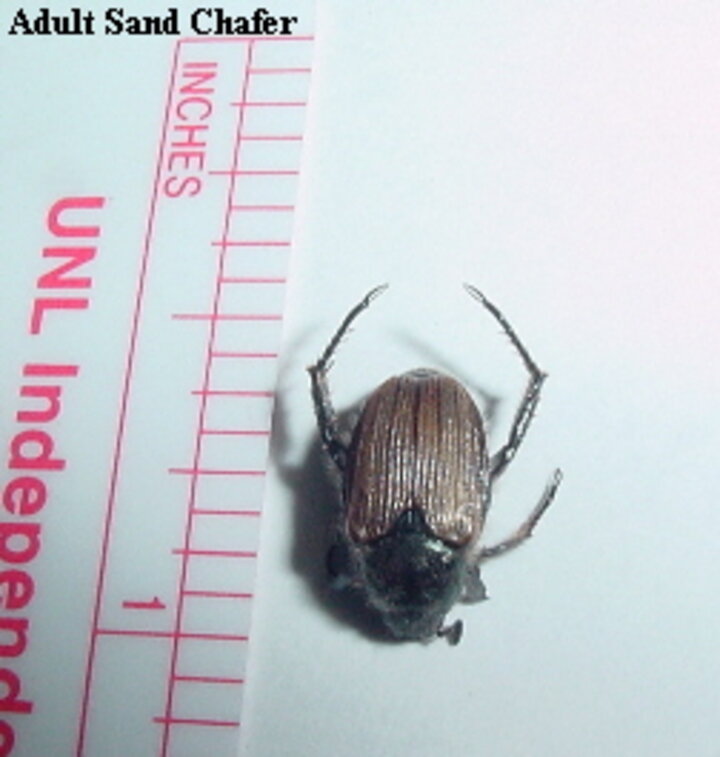
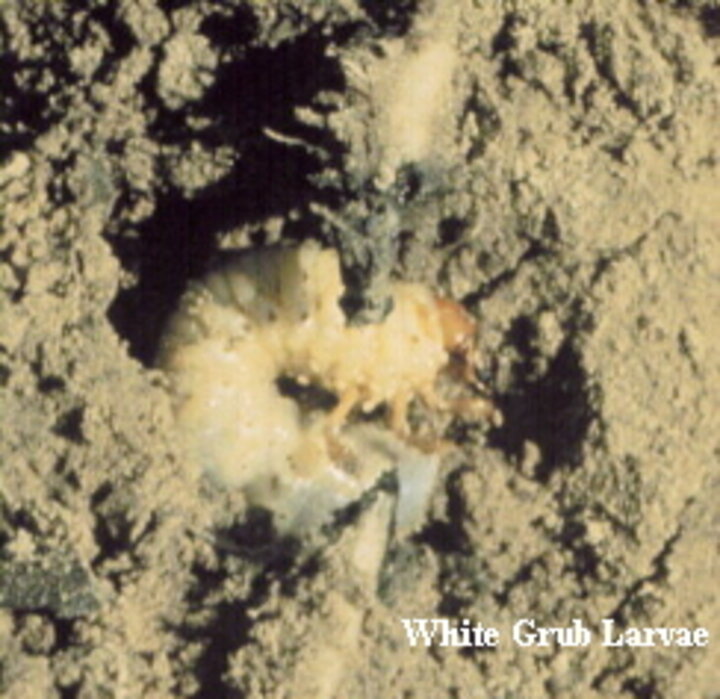
Eggs are deposited in the ground and hatch as larvae commonly called white grubs and these remain under the ground. White grubs are dirty white and partially transparent. They are small, fat and worm-like, and are about an inch long. Their head is brown and behind the head near the front of the grub are six prominent legs.
Life Cycle
The sand chafer has an annual life cycle, going through one generation per year, unlike that of the June beetles. Adults emerge from the ground in early summer, latter half of June and early July. They are highly attracted to light and will land on light-colored clothing, get under clothes and tangle in one’s hair. Adults live about 11 to 31 days. Upon emerging from the ground, adults mate and eggs are deposited in the ground. Peak egg laying time is July. Eggs hatch after 11 to 25 days in August. Hatched from eggs are the larvae or white grubs. These feed on potato tubers in August and September depending on ground temperature. They overwinter deep in the soil for five to 10 months and become active again as the ground warms up in the spring then they pupate and transform into adults. Adults are the only stage in the life cycle that is above ground; all other stages are below ground.
Damage
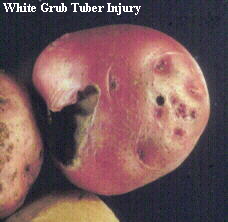
The damaging stage of the life cycle is the larvae or white grub. The overwintered grub feeds little before pupating; there have been a few reports of grub feeding of seed-pieces. Damage occurs on the tubers to be harvested late in the season. As the newly-hatched grubs enlarge, feeding increases. Reports indicate that the worst damage occurs after vine desiccation when done in late August. Vine desiccation reduces ground shading and indirectly allows the ground to warm up more. They move up in the soil due to warmth and encounter the tubers. It has also been suggested that the white grubs feed on the root hairs of the potato plant inflicting little damage but, after vine desiccation, the hairs dry up and the grubs go to the tubers to feed. Damage appears as large, shallow, irregular and ridged gouges. Gouges are usually a quarter to a half inch deep running along the surface of the tuber and not drilled into the tuber as one would see with wireworm holes. White grub feeding ceases as the soil cools and they move deep into the ground to overwinter.
[In corn, white grubs of the sand chafer feed on the root system.]
Control
Sustainable Agriculture
White grubs of the sand chafer affect corn as well as potatoes; large populations are especially found in corn fields planted after soybeans. Since both of these crops are commonly used in rotation with potatoes, crop rotation has little effect in reducing sand chafer populations. Sand chafer and white grub infestation seem to be worst in soils with high organic matter and on ground treated with manures. Otherwise, there is very little known on controlling this pest with cover crops or other methods of sustainable agriculture. When possible, the best is to vine desiccate as late as possible, mid-September and later.
Chemical Management --
As with sustainable agriculture, there is little known about chemical control of sand chafers and their white grubs. Retired Colorado State Univ. entomologist, Dr. Stan Pilcher who identified the sand chafer as a source of white grubs affecting potatoes in the mid-1990s, found this pest to be tolerant to most available insecticides. As of now, I know of no anti-insect product with sand chafer or white grub on its label, although there are a few with rose chafer on theirs. The most effective treatment so far has been using carbofuran (Furadan). In 1999, in a conversation with Dr. Pilcher, he noted that Furadon worked best in laboratory tests showing three to four days of activity against the grub that phorate (Thimet) applied in-furrow followed by Furadan application showed about a 20% reduction of population.
A good program used by some growers in recent years has been applying Furadan by air on adults in early July followed by a late season application of Furadan for white grubs. The late season application should be between mid-August and mid-September, preferably shortly after vine desiccation. NOTE, Furadan can NOT be applied within 14 days of harvest (14-day pre-harvest interval, PHI) and has a 14-day restricted entry interval (REI). Application should be with a ground rig followed quickly by 0.1 to 0.2 inches of irrigation water from a sprinkler to incorporate Furadan down a few inches to the grubs. Furadan works best when incorporated at the end of the season, and it readily moves in water, will leach and spread in wet soil. NOTE, Furadan is NOT labeled for sprinkler irrigation (chemigation) as it will accumulate on the center pivot and affect birds that may wash in or drink from it. Anecdotal reports suggest that imidacloprid (Tops MZ Gaucho, Genesis, Admire, Provado) applied at planting in conjunction with a later Furadan application may be effective in reducing white grub damage on harvested tubers. This still needs to be verified.
Quick Review
Appearance:
- Adults — shiny bronze or copper, ¼-½ long
- Larvae — white grubs, 1 inch long
Life Cycle:
- Annual, one generation
- Adults — late June to early July
- Grub — August to September (overwinters)
Damage:
- Adult — none
- Grub — gouges along tuber surface
Management:
- Crop Rotation — no control after corn
- Desiccation — after Sept. 10
- Manure — avoid application
Chemical:
- Admire/Genesis etc — at planting against emerging adults/grubs
- Furadan — early to mid-season against adults
- Furadan — late season against white grub
Flea Beetle
Potato and Tuber Flea Beetles
There are many small leaf feeding beetles called flea beetles because of their well-developed hind legs that allow them to jump like fleas. In potato, the principle flea beetles are in the genus Epitrix and are considered a minor pests. Of these the potato flea beetle (E. subcritita) and the tuber flea beetle (E. tuberis) are the most economically important. They look very much a like and are hard to distinguish; however they are geographically separate. The potato flea beetle is found from mid-Nebraska east to Maine and along the Atlantic Coast south to the Carolinas. The tuber flea beetle is found from western Nebraska and Colorado west through the inter-mountain States to the Pacific Coast up through the Pacific Northwest.
Description
Adults have an oval body, and their color is shiny green to brown to black. Their hind legs are enlarged for jumping. They are about 1/16 inch long.
Eggs are white and oval. They are deposited in soil crack near the surface and are not seen due to their very small size.
Larvae are elongated soft-bodied grubs about a quarter to a third inch long. Their body is whitish with a yellowish or light brown head. They have six short legs.
Pupa are rarely seen as they form several inches in the soil.
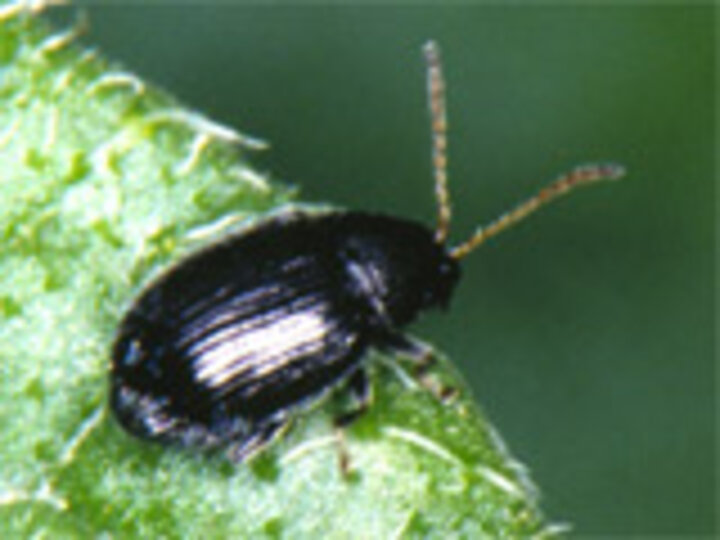
Life Cycle
Adult flea beetles overwinter near where they emerged. They will overwinter in plant debris and weed hosts. The potato and tuber flea beetles usually will burrow into the ground a few inches but may go as deep as a foot and a half. In light soils, many of the adults will go into a hibernation period below normal plowing depth. Adults emerge when the temperature reaches 50oF, between May to early June in the North and earlier in the South, and begin feeding on weeds or Solanaceous bedding plants such as tomato. When potato plants have emerged, many will fly into the potato field and the adults begin feeding on the foliage. Adults mate and eggs are deposited on the soil surface and in its cracks near potato plants. After about 10 days, larvae hatch. The early generations’ larvae feed on roots and underground stems, and sometimes on growing tubers. Mature larvae leave the potato structure and dig a small smooth earthen chamber in which they pupate. Pupation is short; newly-formed adults are soft-shelled and crawl to the surface where their shell hardens and darkens. The cycle normally takes four to six weeks but can be delayed to nine weeks under unfavorable conditions. Normally, there are one to four generations per season depending on locale.
Damage
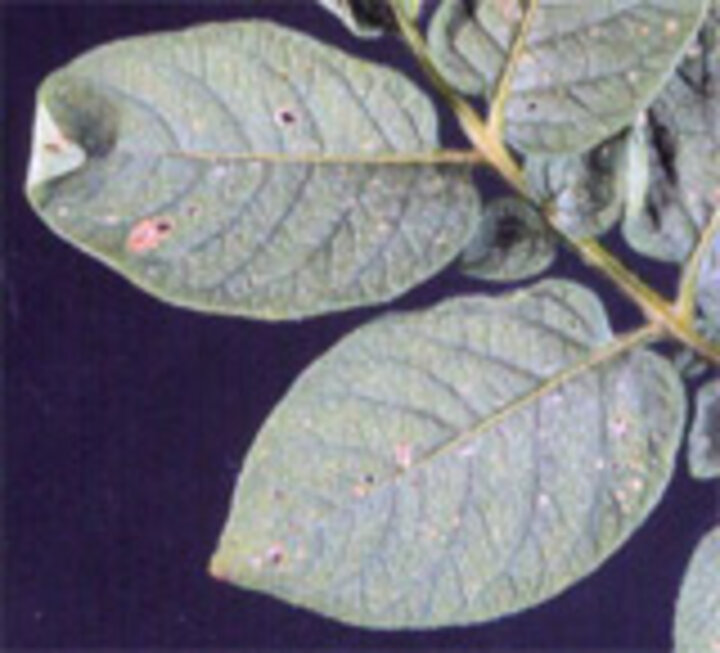
Damage by flea beetles is of two major types, on foliage and on tubers. The principle damage by the potato flea beetle is foliar while the economic damage by the tuber flea beetle is to the tubers to be harvested.
Damage to foliage is from feeding adults of all flea beetles and are small round holes scattered in the leaf blade giving them a “shot hole” or seive-like appearance. A slight chlorosis, yellowing, may occur around the holes. This injury is not economic to treat for and rarely defoliation occurs. Usually only the potato flea beetle, found in the eastern half of North America, will occasionally cause enough foliar injury to be economically important. When the rare severe infestation occurs, plants can defoliate, and tubers can become remain small and become deformed.
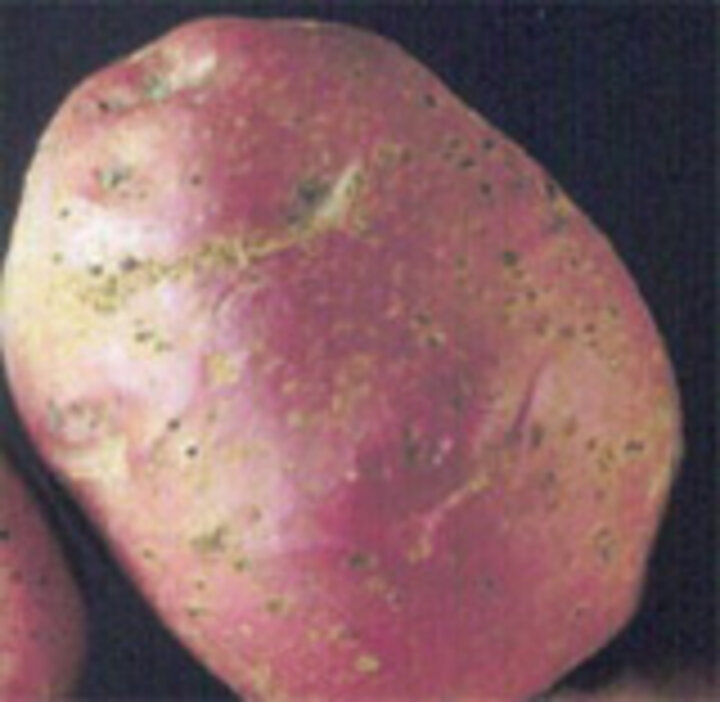
The last generation of larvae cause the most economic damage by feeding on mature tubers. Their feeding results in tubers with narrow, straight tunnels about 1/32 inch wide along the perimeter of the tuber. The tunnels are usually shallow but can extend as much as 1/2 inch deep. The tuber flea beetle, found in the western half of the continent, is especially damaging as they scar the tuber badly and also drill deeper. So, besides holes, small raised bumps also may appear on the tuber surface. Extensive tuber feeding can make the tuber unmarketable for the fresh and processing markets but have no effect on seed tuber vigor. However, there also are reports that the tuber holes can act as entryways for pathogenic bacteria such as soft rot and fungi such as dry rot making the tubers unsuitable for seed as well.
Management
Flea beetle infestation are sporadic and unpredictable; economic thresholds are not known. Since flea beetles tend to stay around potato plants, crop rotation may play a key role. Controlling weeds around and in potato fields is a key part of holding down flea beetle populations. Common, soil-applied systemic insecticides work well in controlling adults. Foliar products used for other pests such as Colorado potato beetle and green peach aphid work well against flea beetle adults. Treatment for larvae are not available.
Quick Review
Appearance:
- Adult — oval; shiny green to black; large hind legs; 1/16 inch
- Larvae — thread-like grubs; whitish; up to 1/3 inch
Life Cycle:
- Overwinters as adults in debris or hibernate
- One to four generations per season
- Generation is 4 to 6 weeks up to 9 weeks
Damage:
- Foliage has shot-hole appearance
- Tubers have narrow tunnels and possibly scars
Management:
- Crop rotation
- Weed control
- Systemic soil insecticides at planting
- Foliar insecticides when used for other pests
Potato Tuber Moth (Tuberworm)
Potato tuber moth (PTM) or tuberworm (PTW) has appeared and spread in the US in the past century. The moth consists of several species. Phthorinaea operculella, the most common, is widely distributed in the world, found in North Africa, and parts of Asia, Europe, the Americas, and Oceania. It is the most widely distributed potato insect in the world. It is usually found in warm climates for overwinter survival and considered a subtropical pest. The moth or worm is considered the most serious pest of potato in tropical and subtropical regions. Recently PTM/PTW has been found in traps in northern latitudes. Whether this northern migration is due to global warming, mutation, etc. is not known. Since it is not a good flier, its migration is attributed primarily due to movement of tubers carrying the pest into storage facilities further north.
Description
PTM/PTW has four stages: adult, egg, larva (damaging), pupa. Adults have a narrow, silver-gray body with grayish-brown wings patterned with small dark spots (pictured). The body length is around a third of an inch and a wing span of an inch (2.54 cm). It is mostly nocturnal and attracted to light. They are poor fliers. Eggs are oval, smooth and yellow, laid alone or in clusters on leaves or near eyes on infested tubers. Larvae, caterpillar-like (PTW, worm), are gray, cream or pale green with a dark brown head about half to three-quarter inch long in the final instar (pictured). Pupae are yellow or rust colored; pupation occurs among dead leaves or debris, in soil, or on stored tubers.
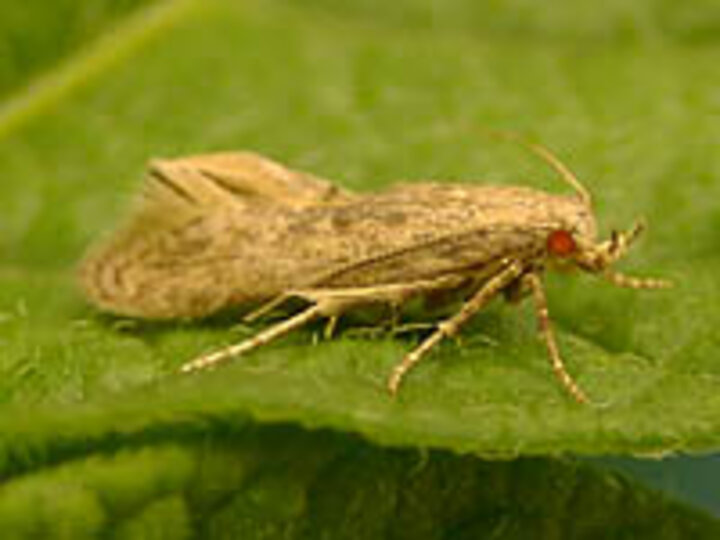

Life Cycle
Generation time is 17 to 125 days depending on temperature, commonly one month. Adult = up to 10 days; egg = 2 to 6 days; larva = 13 to 33 days; pupa = 6 to 29 days. Several generation may form per year. Life cycle can continue in storage on tubers.
Damage
PTM attacks solanaceous crops with potato being favored. Foliar injury is due to the larvae (tuberworm) mining into leaflets, causing them to form transparent blisters, then move into stem tissue causing death. Tubers are marred when larvae reach tubers by two major means. Upon hatching from eggs laid on leaves, larvae can drop to the ground and burrow through cracks in the soil to a tuber, entering it through the eye. This is common after vine desiccation. Another common way is that the female PTM lays its eggs directly on exposed tubers at or near the eye. When the larvae hatch, they just enter the tuber through the eye making a slender tunnel along the surface or deep into the tuber (pictured). A tunnel can be detected by mounds of worm excrement (frass) appearing black at the entrance (pictured). Tunnels do not heal and are entryways for diseases most notably soft rot and dry rot.
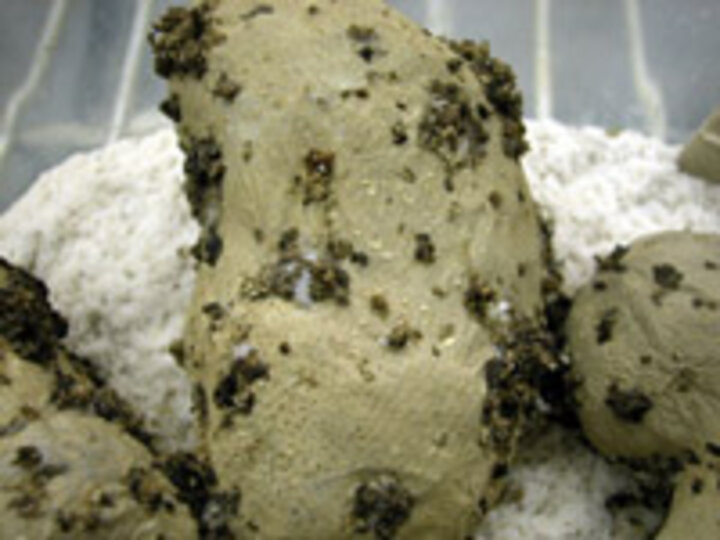
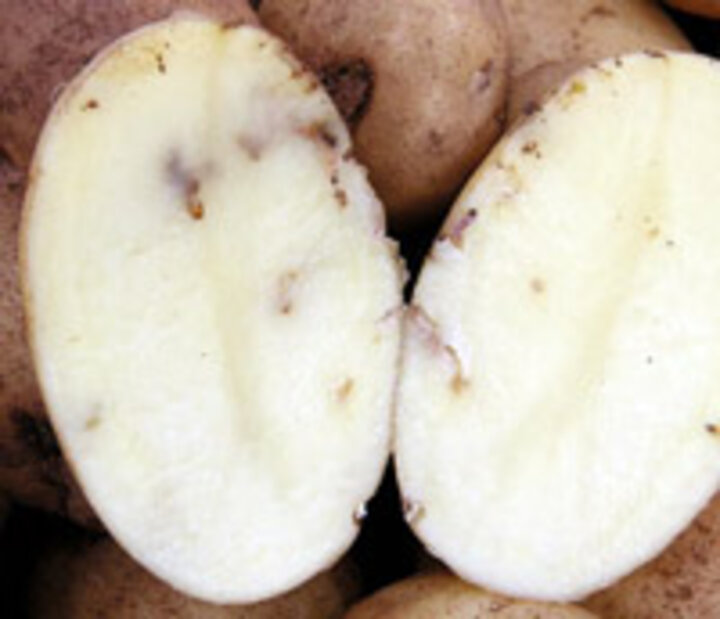
Monitoring
The PTM phermone (male-attracting stimulant) can be used to bait pan-water traps for attracting and monitoring adult male PTM presence. Trapping will give an indication of their presence, population size and distribution, and timing for chemical management. Pan-water traps are recommended due to ease in cleaning between readings. In general, it is suggested to place four traps in each quadrant of a circle, about 50 ft from periphery. Trays should be checked twice per week. Note that economic thresholds have not been determined for potato damage and marketable yield loss. Although there no threshold determined, a reported guide is 15 to 20 PTMs per trap per night would trigger a spray recommendation. Another guide is if the average PTM/trap/night is 10 during the season to that point then field should be treated. These, however, still may be over- or under-estimates.
Field Management
- Reject seed lots from fields or storage that had been infested with PTM or PTW, or tubers that are infested.
- Avoid letting tubers be exposed outside of hill or be shallow, less than two inches covered by soil. Keep potato plants well hilled with tubers adequately covered, deeper planting depth and broader hills.
- Avoid late-season washed out areas as this will expose tubers above ground and PTMs can lay their eggs on the exposed tubers.
- Avoid deep soil cracks (2 inches and greater) using cultural practices such as irrigation. This will inhibit female PTM from laying eggs on the tubers and wandering PTW from getting through soil to the tubers.
- Irrigate slightly after vine desiccation to avoid soil cracking and harvest tubers as soon as skin sets.
- Do not leave potato tubers in containers in the field overnight; likewise do not dig and leave tubers atop of ground to be picked up the next day and stored. At night the female PTM is most active laying eggs.
- Do not use vines as a cover for tubers as the PTW will move from them to tubers as the vines wilt.
- Bury or feed to cattle cull piles or in some way destroy them.
- Eliminate volunteer potato plants.
Chemical Management
Insecticides used against leafhoppers and aphids are adequate against PTM during the early part of the season but best applications are toward the end of the season when vines are dying and tubers are maturing.
- Current products active against PTM (adult) and PTW (larvae) even when PTWs are in leaf tissue are Furadan, Lannate, Monitor, and Penncap M. (source: Alan Schreiber, Eltopia, WA)
- Current products active against PTM and PTW but not when PTWs are in leaf tissue are Asana, Baythroid, Guthion, Imidan, and Leverage. (source: Alan Schreiber, Eltopia, WA)
- For home gardens, apply Sevin to foliage for general insect control. Treat 10 to three days before harvesting. Bt may also be used if applied at the right timing to kill PTW but note has no effect on PTM.
There are no products registered for storage control of PTM/PTW.
Predation
The only natural predators identified are two wasp species that attack PTW.
Storage Management
PTM/PTW damage is year long as the PTM will continue to breed in storage and lay eggs which will hatch into PTW. The length of the life cycle will depend on the storage temperature.
- Sanitize storage facility (walls, floors, ceiling).
- Treat facility with malathione, if PTM or PTW was detected the previous year.
- Keep storage temperatures below 52 deg F.
- Screen storage area from the outside to keep out PTMs.
- If potato sacks, crates or other containers are used, they should be new or thoroughly sanitized.
Varietal Resistance
Varieties that are thought as resistant are those that set tubers deeper in the ground. But, if there are deep cracks through which the PTM or PTW can travel to tubers, the tubers will infested; likewise, they will infest tubers on the ground. Therefore, there is no real resistance.
References
- Insects and Related Pests. 2006 In Integrated Pest Management for Potatoes in the Western United States, 2nd Edition, Ed. L.L. Strand, Publ. Univ Calif Agric and Nat Resources, Pub. 3316.
- Foot, M. 1998. Potato Tuber Moth Life Cycle. HortFact (on-line), The Horticulture and Food Research Inst of New Zealand.
- Sorensen, K.A. 1994. Potato Tuberworm. Vegetable Insect Pest Management: Insect Note, North Carolina State Univ. (online publication)
- Spring, A. and E. Day. 2006. Potato Tuberworm. Insect Identification Lab. Virginia Tech. (online publication)

